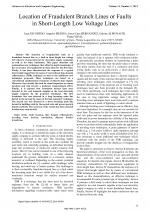| 3/2014 - 4 |
Location of Fraudulent Branch Lines or Faults in Short-Length Low Voltage LinesESCOBEDO, J. |
| View the paper record and citations in |
| Click to see author's profile in |
| Download PDF |
Author keywords
fault location, time domain reflectometry, traveling wave devices, correlation, discrete Fourier transforms
References keywords
fault(16), power(11), transmission(9), system(8), lines(8), location(7), locator(6), time(5), systems(4), protection(4)
Blue keywords are present in both the references section and the paper title.
About this article
Date of Publication: 2014-08-31
Volume 14, Issue 3, Year 2014, On page(s): 33 - 40
ISSN: 1582-7445, e-ISSN: 1844-7600
Digital Object Identifier: 10.4316/AECE.2014.03004
Web of Science Accession Number: 000340869800004
SCOPUS ID: 84907359410
Abstract
The detection of irregularities such as a fraudulent branch line or a fault in short-length low voltage (LV) lines is of great interest for electricity supply companies as well as for other businesses. This paper describes and systematizes new techniques that afford in-depth knowledge of the occurrence of irregularities in these lines for the first time. Firstly, it has been characterized the response of a typical short-length tapped line by means of conventional time-domain reflectometry (TDR) technique as well as the additional new techniques proposed. These techniques are based on a conventional mathematical treatment of discrete-time signals. Moreover, they obviate the need for visual inspection at remote locations and only involve a moderate computational effort. Finally, it is exposed how fraudulent branch lines were detected in two real domestic supplies at the local electricity supply company by the proposed techniques. The first fraudulent line was detected in a long incoming main line buried in the ground by mean of the line-symmetry technique. The second one was detected in a short incoming main line located in building voids by the second echo and power spectral density methods. The accuracy of the results has been assessed in laboratory tests as well. |
| References | | | Cited By |
Web of Science® Times Cited: 3 [View]
View record in Web of Science® [View]
View Related Records® [View]
Updated 3 days, 1 hour
SCOPUS® Times Cited: 4
View record in SCOPUS® [Free preview]
View citations in SCOPUS® [Free preview]
[1] Real Fault Section Estimation in Electrical Distribution Networks Based on the Fault Frequency Component Analysis, Gord, Ehsan, Dashti, Rahman, Najafi, Mojtaba, Shaker, Hamid Reza, Energies, ISSN 1996-1073, Issue 6, Volume 12, 2019.
Digital Object Identifier: 10.3390/en12061145 [CrossRef]
[2] Identification of the source location Neutral to Earth Voltage (NTEV) rise on the commercial building, Mat Yusoh, Mohd Abdul Talib, Abidin, Ahmad Farid, Mat Yasin, Zuhaila, Sy Yi, Sim, Ain Shams Engineering Journal, ISSN 2090-4479, Issue 2, Volume 10, 2019.
Digital Object Identifier: 10.1016/j.asej.2019.03.006 [CrossRef]
[3] Monitoring technical losses to improve non-technical losses estimation and detection in LV distribution systems, Henriques, H.O., Corrêa, R.L.S., Fortes, M.Z., Borba, B.S.M.C., Ferreira, V.H., Measurement, ISSN 0263-2241, Issue , 2020.
Digital Object Identifier: 10.1016/j.measurement.2020.107840 [CrossRef]
[4] Identification of Source Neutral-to-Earth-Voltage (NTEV) Rise in The Commercial Building, Talib Mat Yusoh, Mohd Abdul, Abidin, Ahmad Farid, Zin, Nooradzianie Muhammad, Hamid, Zulkiffli Abdul, Mohammad, Nurul Nadia, Nik Ali, Nik Hakimi, 2021 IEEE International Conference in Power Engineering Application (ICPEA), ISBN 978-1-7281-8546-0, 2021.
Digital Object Identifier: 10.1109/ICPEA51500.2021.9417848 [CrossRef]
Disclaimer: All information displayed above was retrieved by using remote connections to respective databases. For the best user experience, we update all data by using background processes, and use caches in order to reduce the load on the servers we retrieve the information from. As we have no control on the availability of the database servers and sometimes the Internet connectivity may be affected, we do not guarantee the information is correct or complete. For the most accurate data, please always consult the database sites directly. Some external links require authentication or an institutional subscription.
Web of Science® is a registered trademark of Clarivate Analytics, Scopus® is a registered trademark of Elsevier B.V., other product names, company names, brand names, trademarks and logos are the property of their respective owners.
Faculty of Electrical Engineering and Computer Science
Stefan cel Mare University of Suceava, Romania
All rights reserved: Advances in Electrical and Computer Engineering is a registered trademark of the Stefan cel Mare University of Suceava. No part of this publication may be reproduced, stored in a retrieval system, photocopied, recorded or archived, without the written permission from the Editor. When authors submit their papers for publication, they agree that the copyright for their article be transferred to the Faculty of Electrical Engineering and Computer Science, Stefan cel Mare University of Suceava, Romania, if and only if the articles are accepted for publication. The copyright covers the exclusive rights to reproduce and distribute the article, including reprints and translations.
Permission for other use: The copyright owner's consent does not extend to copying for general distribution, for promotion, for creating new works, or for resale. Specific written permission must be obtained from the Editor for such copying. Direct linking to files hosted on this website is strictly prohibited.
Disclaimer: Whilst every effort is made by the publishers and editorial board to see that no inaccurate or misleading data, opinions or statements appear in this journal, they wish to make it clear that all information and opinions formulated in the articles, as well as linguistic accuracy, are the sole responsibility of the author.





